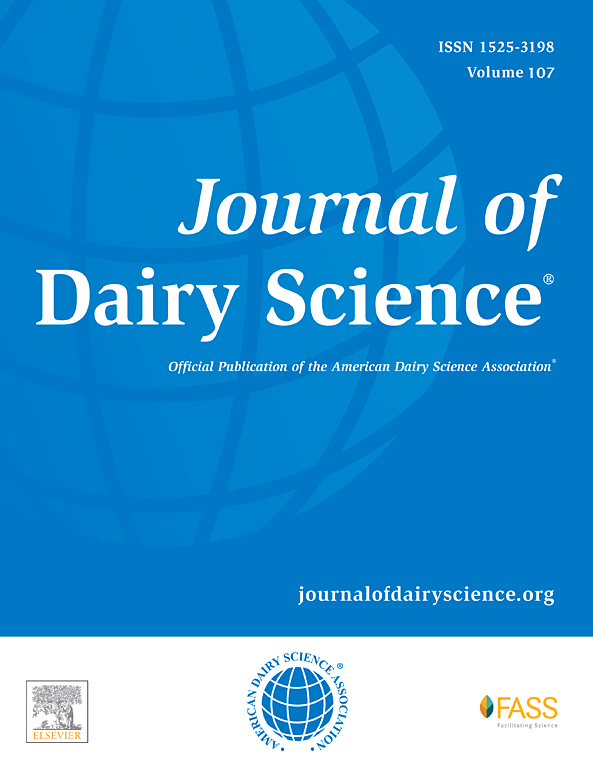从牛奶光谱预测的血液参数是高酮血症的候选指标特征-意大利荷尔斯坦人群的回顾性研究。
IF 4.4
1区 农林科学
Q1 AGRICULTURE, DAIRY & ANIMAL SCIENCE
引用次数: 0
摘要
在泌乳开始时,高产奶牛通常面临负能量平衡和随之而来的代谢紊乱,如高酮血症。非酯化脂肪酸(NEFA)、BHB、胆固醇、葡萄糖和尿素的血药浓度为哺乳动物的代谢、健康和营养状况提供了有价值的信息。牛奶中红外(MIR)光谱已经成功地用于预测几种健康特征,包括血液代谢物的浓度,尽管模型的准确性是中等的。事实上,mir预测的血液参数对群体筛选是有用的,如果它们在群体中是可遗传的和遗传可变的,则可用于选择性育种。在本研究中,我们利用460个畜群中9943头奶牛的表型,估计了h2和mir预测的BHB、NEFA、葡萄糖、胆固醇和尿素的遗传相关性,并评估了它们与意大利荷斯坦奶牛群体产奶量和组成性状的遗传相关性。研究人员考虑了两组:早期(8277条记录——每头奶牛1条记录——产奶5至35天)和全乳(105293条记录——每头奶牛至少5条记录——产奶5至305天)。血液性状的h2和遗传变异性在哺乳期早期大于全哺乳期,证实在过渡时期存在通过选择操纵代谢性疾病发病率的空间。无论哺乳期早期和全哺乳期,血BHB的遗传系数最高(分别为0.13和0.08),NEFA的遗传系数最低(h2与0无显著差异)。血BHB与NEFA呈遗传正相关,而葡萄糖与BHB、NEFA和尿素呈遗传负相关。血BHB、NEFA和胆固醇与乳脂蛋白比普遍呈正相关;BHB与乳糖含量呈负相关,与SCS呈正相关。对至少有20个具有表型的子代的母猪的估计育种值进行外推,以便对观察到的性能进行事后评估。与其他奶牛相比,前5种奶牛的后代高酮血症发生率较低,只有2.16%的奶牛BHB浓度高于常规阈值(1.2 mmol/L)。相反,低5位公牛后代的高酮血症患病率高出5倍(10.55%,BHB为1.2 mmol/L)。这些发现表明,尽管h2估计较低,但仍有空间确定与奶牛代谢相关的性状具有低或高遗传优点的动物。因此,选择健康和抗代谢奶牛是可行的,红外预测的血液性状是潜在的辅助性状。本文章由计算机程序翻译,如有差异,请以英文原文为准。
Blood parameters predicted from milk spectra are candidate indicator traits of hyperketonemia—A retrospective study in the Italian Holstein population
At the onset of lactation, high-producing dairy cows commonly face a negative energy balance and metabolic disorders, such as hyperketonemia. Blood concentrations of nonesterified fatty acids (NEFA), BHB, cholesterol, glucose, and urea provide valuable information about the metabolic, health, and nutritional status of lactating cows. Milk mid-infrared (MIR) spectroscopy has been successfully used for the prediction of several health traits in the last years, including blood metabolite concentrations, even though the model accuracy is moderate. In fact, MIR-predicted blood parameters are useful for population screening and may be used for selective breeding if they are heritable and genetically variable within a population. In the present study, we estimated h2 and genetic correlations of BHB, NEFA, glucose, cholesterol, and urea and assessed their genetic correlations with milk yield and composition traits in the Italian Holstein population using phenotypes of 9,943 cows in 460 herds. Two datasets were considered: early lactation (8,277 test-day records between 5 and 35 DIM) and whole lactation (105,293 test-day records, between 5 and 305 DIM). The h2 and genetic variability of blood traits were greater in early than whole lactation, suggesting that there is room to manipulate metabolic disease incidence in the transition period through tailored genetic strategies. Blood BHB was the most heritable trait, regardless of the lactation stage (with h2 of 0.13 and 0.08 in early and whole lactation), whereas blood NEFA was the least heritable trait, with h2 not significantly different from zero. Blood BHB was positively genetically correlated with NEFA, whereas glucose was negatively correlated with BHB, NEFA, and urea. The milk fat-to-protein ratio was correlated with BHB, NEFA, and cholesterol, whereas a negative correlation was calculated between lactose content and BHB and between SCS and BHB. Estimated breeding values of sires with at least 20 daughters with phenotypes available were extrapolated for a posteriori evaluation of the observed performance. The progeny of the top 5 sires exhibited a lower incidence of hyperketonemia compared with the other cows, with only 2.16% of cows having BHB concentrations above the conventional threshold (1.20 mmol/L). Conversely, the prevalence of hyperketonemia was 5 times higher in the offspring of the bottom 5 bulls (10.55% of cows with BHB above the threshold of 1.20 mmol/L). These findings suggest that, despite the low h2 estimates, there is room to identify animals with low or high genetic merit for traits linked to metabolism. Therefore, selection toward healthier and metabolically resistant cows is pursuable, with MIR-predicted blood traits being potential auxiliary traits for selective breeding.
求助全文
通过发布文献求助,成功后即可免费获取论文全文。
去求助
来源期刊

Journal of Dairy Science
农林科学-奶制品与动物科学
CiteScore
7.90
自引率
17.10%
发文量
784
审稿时长
4.2 months
期刊介绍:
The official journal of the American Dairy Science Association®, Journal of Dairy Science® (JDS) is the leading peer-reviewed general dairy research journal in the world. JDS readers represent education, industry, and government agencies in more than 70 countries with interests in biochemistry, breeding, economics, engineering, environment, food science, genetics, microbiology, nutrition, pathology, physiology, processing, public health, quality assurance, and sanitation.
 求助内容:
求助内容: 应助结果提醒方式:
应助结果提醒方式:


